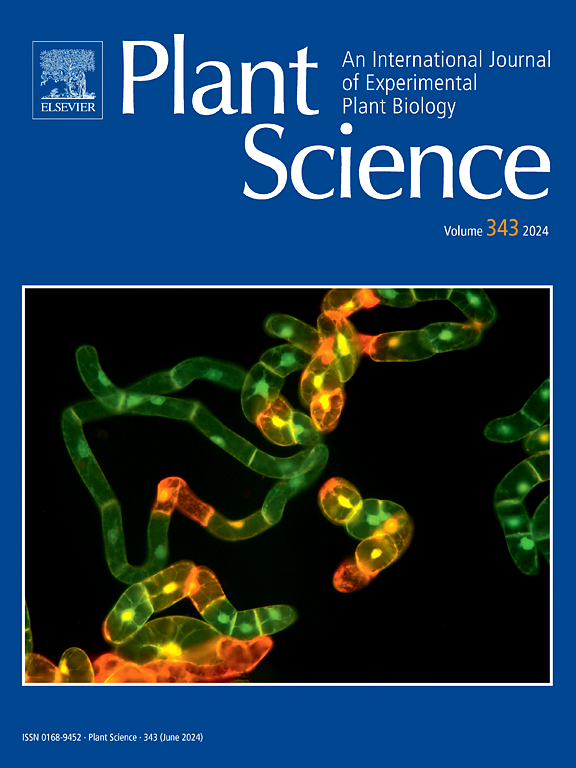CRISPR/Cas9-mediated gene editing of MsCLE3a confers compact alfalfa architecture
IF 4.2
2区 生物学
Q2 BIOCHEMISTRY & MOLECULAR BIOLOGY
引用次数: 0
Abstract
Alfalfa (Medicago sativa L.) is a globally major forage crop for livestock due to its superior nutritional value and palatability. As a premium forage species, alfalfa breeding has traditionally emphasized high yield. In this study, we designed guide RNA (gRNA) to target the coding sequence of the MsCLE3a gene, and constructed a CRISPR/Cas9 vector to generate knockouts. Five mutant lines were successfully isolated, displaying upright petioles and a compact ternately compound leaf phenotype during the seedling stage. Cryo-scanning electron microscopy (Cryo-SEM) was employed to analyze cell morphology on the abaxial leaf surface. The results indicated that the cells on the abaxial side of the Mscle3a mutants were significantly elongated compared to the wild type (WT). Transcriptomic analysis further uncovered the down-regulation of brassinosteroid (BR) biosynthesis genes in Mscle3a mutants, which might underlie the mechanisms regulating petiole angle. Quantitative reverse transcription-polymerase chain reaction (qRT-PCR) analysis revealed a major reduction in the transcript levels of several key genes involved in BR signaling pathways in the Mscle3a mutants relative to WT. This transcriptional down-regulation was strongly associated with the observed alterations in leaf petiole angle (LPA) in the mutant lines. Our findings provide novel insights into the novel regulatory role of MsCLE3a in alfalfa development and pinpoint potential targets for manipulating LPA in crop breeding programs.
CRISPR/ cas9介导的MsCLE3a基因编辑赋予了紧凑的苜蓿结构
紫花苜蓿(Medicago sativa L.)因其优越的营养价值和适口性而成为全球主要的牲畜饲料作物。作为一种优质牧草,苜蓿的育种传统上强调高产。在本研究中,我们设计了针对MsCLE3a基因编码序列的引导RNA (gRNA),并构建了CRISPR/Cas9载体来产生敲除。成功分离了5个突变系,在苗期表现为直立叶柄和紧密的三联叶表型。采用低温扫描电镜(Cryo-SEM)对叶片背面的细胞形态进行了分析。结果表明,与野生型(WT)相比,Mscle3a突变体背面的细胞明显拉长。转录组学分析进一步揭示了Mscle3a突变体中油菜素内酯(brassinosteroids, BR)生物合成基因的下调,这可能是叶柄角调控机制的基础。定量逆转录聚合酶链反应(qRT-PCR)分析显示,与WT相比,Mscle3a突变体中涉及BR信号通路的几个关键基因的转录水平显著降低,这种转录下调与观察到的突变系叶柄角(LPA)的改变密切相关。我们的研究结果为MsCLE3a在苜蓿发育中的新调控作用提供了新的见解,并确定了在作物育种计划中操纵LPA的潜在靶点。
本文章由计算机程序翻译,如有差异,请以英文原文为准。
求助全文
约1分钟内获得全文
求助全文
来源期刊

Plant Science
生物-生化与分子生物学
CiteScore
9.10
自引率
1.90%
发文量
322
审稿时长
33 days
期刊介绍:
Plant Science will publish in the minimum of time, research manuscripts as well as commissioned reviews and commentaries recommended by its referees in all areas of experimental plant biology with emphasis in the broad areas of genomics, proteomics, biochemistry (including enzymology), physiology, cell biology, development, genetics, functional plant breeding, systems biology and the interaction of plants with the environment.
Manuscripts for full consideration should be written concisely and essentially as a final report. The main criterion for publication is that the manuscript must contain original and significant insights that lead to a better understanding of fundamental plant biology. Papers centering on plant cell culture should be of interest to a wide audience and methods employed result in a substantial improvement over existing established techniques and approaches. Methods papers are welcome only when the technique(s) described is novel or provides a major advancement of established protocols.
 求助内容:
求助内容: 应助结果提醒方式:
应助结果提醒方式:


